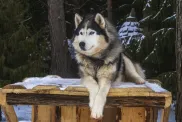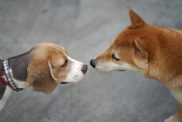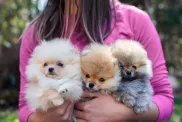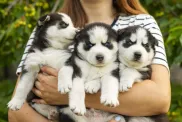The Calupoh, or Mexican Wolfdog, is a unique hybrid breed developed in Mexico by combining domestic dogs with Mexican gray wolves. This effort began in the mid-1990s to create a breed that reflects Mexico’s cultural heritage while maintaining a stable and manageable temperament suitable for companionship. Calupohs are medium to large-sized dogs, distinguished by their wolf-like appearance, which includes a lithe, muscular build, long legs, and dense fur. Their striking features often include piercing eyes and a coat that varies from black to gray, though black is the most characteristic color, and the breed sometimes colloquially goes by the name “Black Wolfdog.” The breed embodies traits of loyalty, intelligence, and strength, making them appealing as working or companion animals.
Despite their wild ancestry, the Calupoh temperament is known for being calm and gentle, a result of selective breeding that emphasizes stability and adaptability. They thrive in environments where they can exercise regularly and bond closely with their human families. Culturally, the Calupoh holds a special place in Mexican history and symbolism, as wolves have long been revered in Mesoamerican mythology. The breed represents a modern effort to reconnect with and preserve the legacy of native wildlife, blending the ancient and the contemporary in a uniquely Mexican breed.
Calupoh characteristics
- Height: 22 to 29 inches tall at the shoulder
- Weight: 60 to 120 pounds
- Lifespan: 10 to 14 years
Coat and color variations
The Calupoh features a distinctive double-layered coat that is both functional and aesthetically striking. The outer layer has a coarse texture, providing durability and protection, while the inner layer is soft and insulating, ensuring adaptability to various weather conditions. The coat is medium in length, likely a trait inherited from their wolf ancestry.
The preferred coat color is black or smoky black. As they mature, some dogs may develop a silver sheen, another characteristic inherited from their wolf ancestors. While black is the most desirable, some Calupohs may be born white/sable or fully sable; however, these colors are less favored within the breed standard. White markings on the chest and feet, as well as brown “socks” on the legs, are permitted, but additional markings are not acceptable per the breed standard.
Calupoh physical traits and attributes
Size and build
- Size: Medium to large-sized breed, with a lithe, muscular build.
- Body: Lean and athletic, designed for endurance and agility. They also have long legs and a deep chest for strength and stamina.
Coat texture and colors
- Coat: Double-layered: rough-textured outer layer and soft, insulating underlayer. Medium length, weather-resistant, and suited for various climates.
- Colors: Black or smoky black are most desirable. Silvering may occur in some adults, reflecting wolf ancestry.
- Markings: White spots on the chest and feet are permitted per the breed standard.
Facial features
- Head: Wolf-like, with a strong, balanced profile. Calupohs have erect ears.
- Eyes: Almond-shaped with colors typically varying between amber and dark brown. Amber is usually preferred.
- Mandible: Strong and powerful. Full dentition with a scissor bite; pincer bite is acceptable.
Other physical attributes
- Tail: Bushy and carried low when relaxed, higher when alert.
- Mane: Develops a wolf-like mane upon maturity.
Calupoh personality
The Calupoh temperament is known for being balanced and adaptable. Despite their wolf ancestry, they exhibit a calm and gentle demeanor, thanks to careful breeding aimed at tempering wild instincts. Calupohs are highly intelligent, quick learners, and deeply bond with their human families, showing loyalty and protectiveness without unnecessary aggression. They thrive in environments where they can engage in regular physical activity and mental stimulation, making them well-suited for active households. While they are generally sociable and even-tempered, early socialization is essential to ensure they remain confident and well-behaved in diverse situations.
Temperament and behavior traits
- Temperament: Calm and gentle, with a balanced demeanor.
- Intelligence: Highly intelligent and quick to learn.
- Loyalty: Deeply bonds with its family and is protective without being overly aggressive.
- Sociability: Generally sociable, but benefits greatly from early socialization.
- Energy Level: Active and thrives with regular physical activity and mental stimulation.
- Adaptability: Adapts well to various environments when properly exercised and cared for.
- Trainability: Eager to please and responds well to consistent training.
- Confidence: Exhibits self-assurance when socialized and trained early.
- Working Ability: Strong and capable, suited for tasks requiring endurance and focus.
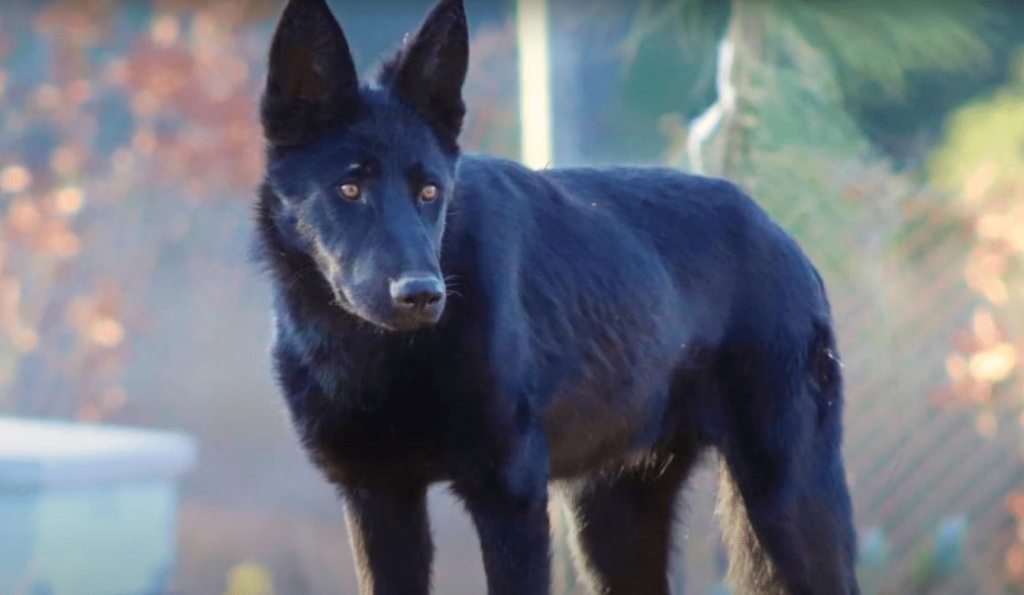
Training and socialization
Mexican Wolfdogs respond well to positive reinforcement training methods. Early socialization is crucial to prevent potential shyness or aggression. Consistent training and mental stimulation are essential for this breed.
Training tips:
- Be Consistent: Consistency is crucial in training. Use the same commands and routines to avoid confusion. This helps your Calupoh understand what is expected of them.
- Keep Training Sessions Short and Fun: Calupoh are intelligent but can lose interest if training sessions are too long or repetitive. Keep sessions short (10-15 minutes) and engage with varied activities.
- Mental Stimulation: Incorporate puzzle toys, obedience training, and interactive games into their routine to challenge their mind. A bored Calupoh can become restless or destructive. Once basic obedience is established, teach more advanced commands or tricks. Their intelligence makes them excellent candidates for agility training, fetch, or scent games.
Calupoh care
As with all dogs, it’s important to keep up your Calupoh’s regular veterinary checkups to detect any health concerns early. Your vet can help you develop a care routine that will keep your dog healthy.
Calupoh grooming needs
The Calupoh has moderate grooming needs, primarily due to their dense, double-layered coat. Regular brushing is essential to maintain the coat’s health and to reduce shedding, particularly during seasonal coat changes. The outer layer, with its rough texture, helps protect the dog from weather, while the soft undercoat requires attention to prevent matting. Bathing should be occasional, only when necessary, as over-washing can strip the coat of its natural oils. Attention to other grooming basics, such as nail trimming, ear cleaning, and dental care, is also important to keep the Calupoh healthy and comfortable.
How to groom a Calupoh
- Brushing: Use a slicker brush or undercoat rake to brush the coat 2–3 times a week. Focus on removing loose fur and preventing mats, especially during shedding seasons.
- Bathing: Bathe only when the coat is dirty or has a noticeable odor. Use a mild, dog-safe shampoo to protect the natural oils.
- Nail Trimming: Trim nails every 3–4 weeks or as needed to prevent overgrowth and cracking.
- Ear Cleaning: Check ears weekly for dirt, debris, or signs of infection. Clean with a vet-approved ear cleaner if needed.
- Dental Care: Brush teeth 2–3 times a week using dog-specific toothpaste to maintain oral health.
- Seasonal Shedding: Increase brushing frequency during seasonal coat changes to manage shedding effectively.
Early acclimation is key
Getting your Calupoh accustomed to grooming procedures from a young age makes the process easier and more enjoyable for both of you. Handle their paws frequently, examine their mouth and ears, and reward them for good behavior during grooming sessions. This positive foundation sets the stage for stress-free veterinary exams and handling throughout their lives.
Feeding Guidelines
An ideal Calupoh diet should be formulated for a medium-to-large breed with high energy. Calupohs benefit from a balanced, high-quality diet that meets their nutritional needs, supporting their active lifestyle and maintaining their lean, muscular build. Care should be taken to avoid overfeeding, as excess weight can lead to health problems, especially if they are not getting adequate exercise.
As with all dogs, a Calupoh’s dietary requirements will change from puppyhood to adulthood and into their senior years. Consult with a veterinarian to determine the most appropriate diet for your Calupoh, as individual factors like age, weight, activity level, and overall health can influence their nutritional needs.
Puppy diet
- Feed a high-quality puppy food designed for large breeds. Divide daily portions into 3–4 small meals to support steady growth and prevent bloating.
Adult portions:
- For an adult Calupoh weighing 50–80 lbs, feed approximately 2.5–4 cups of dry food per day, split into two meals. Adjust portions based on the dog’s weight, size, and activity level.
Senior diet:
- Switch to a senior formula as your Calupoh ages, typically around 7–8 years. These diets are lower in calories but still provide essential nutrients for joint health and overall vitality.
Calupoh family compatibility
The Calupoh is a highly adaptable breed that can form strong bonds with their family, making them an excellent companion for those who appreciate their loyal and protective nature. With proper training and early socialization, the Calupoh is gentle and affectionate, even in households with children. This breed thrives on being part of a “pack,” whether it’s their human family or other pets, and they are happiest when they feel included in daily activities. Their protective instincts, inherited from both domestic and wolf ancestry, make them naturally cautious around strangers. Still, this trait can be managed with consistent exposure to new people and environments from a young age. Their intelligence and eagerness to please make training relatively straightforward provided it is done with patience and positive reinforcement.
Socialization is crucial for a Calupoh to develop into a confident and well-rounded adult. Starting at an early age, they should be introduced to various people, animals, and situations to help them learn appropriate behaviors and reduce any potential wariness or shyness. Without proper socialization, their natural protective tendencies may lead to over-guarding or anxiety in unfamiliar situations.
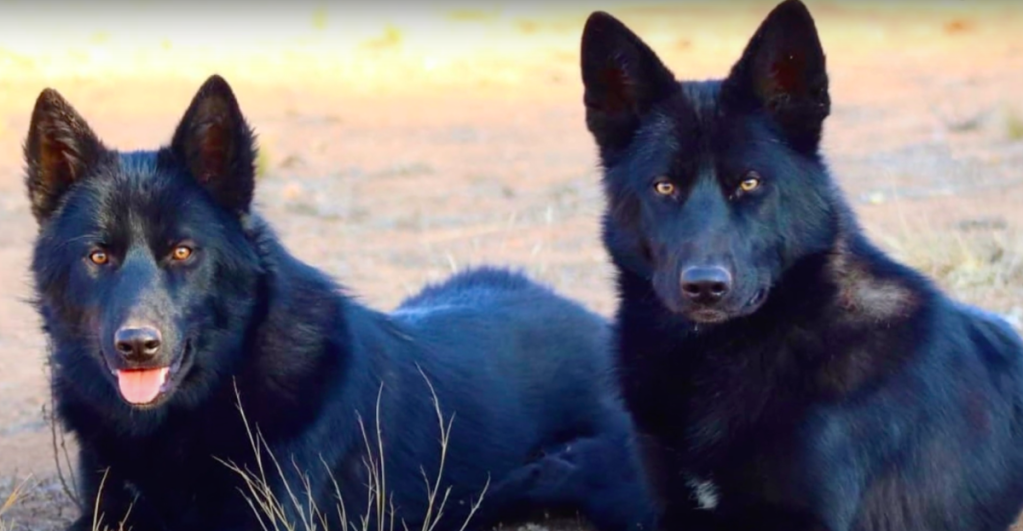
Calupoh health
The Calupoh is generally a robust and healthy breed, benefiting from its hybrid genetics, which often provide greater resistance to hereditary conditions. However, like all dogs, they are not immune to certain health issues, particularly those common in medium-to-large breeds and their wolf and dog ancestry. Owners should be aware of potential problems and take preventative measures to ensure their Calupoh’s long-term health.
Potential health issues in the Calupoh
- Hip Dysplasia: A common concern in larger breeds where the hip joint doesn’t fit properly into the socket, potentially causing pain and mobility issues over time.
- Elbow Dysplasia: Similar to hip dysplasia but affecting the elbow joints, leading to discomfort and lameness in severe cases.
- Bloat (Gastric Dilatation-Volvulus): A life-threatening condition where the stomach twists, often linked to eating large meals too quickly. Feeding smaller, more frequent meals and avoiding vigorous exercise immediately after eating can help prevent this.
- Degenerative Joint Diseases: Arthritis and other joint issues can occur in older Calupohs, particularly if they are highly active or not maintained at an optimal weight.
- Eye Issues: Conditions like cataracts or progressive retinal atrophy (PRA) could occasionally appear, although not widespread in the breed.
- Parasitic and Zoonotic Diseases: Due to their wolf ancestry, ensuring a strict parasite prevention program is critical, especially if the dog has access to outdoor or rural areas.
Calupoh rescue groups
Finding a Calupoh rescue may be challenging due to their rarity. However, you might have better luck through rescues focused on the education and preservation of various types of wolfdogs. Below are a few organizations that may help connect you with a Calupoh or another wolfdog for adoption:
If you choose to buy a Calupoh puppy, finding a reputable dog breeder is crucial. Reputable breeders are committed to breeding healthy, well-socialized puppies that will make great companions. They will screen their breeding stock for health problems, socialize their puppies from a young age, and provide you with lifetime support.
Is owning a Calupoh legal?
Owning a Calupoh is generally legal in most places, as it is considered a domesticated breed despite its wolf ancestry. Unlike first-generation wolf hybrids, which can be subject to strict regulations or outright bans in certain regions, the Calupoh is selectively bred for temperament and manageability, making it more widely accepted. However, regulations can vary depending on the country, state, or municipality.

